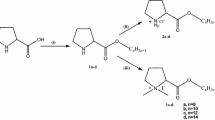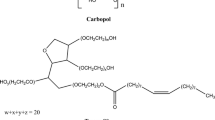Abstract
Two propoxylated quaternary amine surfactants characterized by two and six average PO adduct numbers (PO-2 and PO-6 QA surfactants) were synthesized to investigate the micellar properties of propoxylated cationic surfactants in water/alcohol mixtures. The effect of PPO groups on micelle formation was explored using conductivity, UV–vis spectroscopy, dynamic light scattering techniques. Regular or reverse micellization occur with water or alcohol rich solvent mixtures, respectively. For intermediate composition no micellization occurs. Also the performances in antibacterial and antistatic fabrics were studied. PO-2 QA surfactant has excellent antibacterial activities against both the Gram-negative bacterium Escherichia coli and the Gram-positive bacterium Staphylococcus aureus while both surfactants have good antistatic activity over polyester fabric.








Similar content being viewed by others
References
Bagshaw SA, Prouzet E, Pinnavaia TJ (1995) Templating of mesoporous molecular sieves by nonionic polyethylene oxide surfactants. Science 269:1242–1244
Castronuovo CC, Cuestas ML, Oubiña JR, Mathet VL (2015) Effect of several PEO–PPO amphiphiles on bax, bcl-2, and hTERT mRNAs: an insight into apoptosis and cell immortalization induced in hepatoma cells by these polymeric excipients. Biotechnol Appl Bioc 3:1–8
Bromberg L, Temchenko M (1999) Self-assembly in aqueous solutions of poly(ethylene oxide)-b-poly(propylene oxide)-b-poly(ethylene oxide)-b-poly(vinyl alcohol). Langmuir 15:8633–8639
Du YZ, Weng Q, Yuan H, Hu FQ (2010) Synthesis and antitumor activity of stearate-g-dextran micelles for intracellular doxorubicin delivery. ACS Nano 4:6894–6902
Orlich B, Schomäcker R (2002) Enzyme catalysis in reverse micelles. History and trends in bioprocessing and biotransformation. Springer, Berlin, Heidelberg, pp 185–208
Taleb A, Petit C, Pileni MP (1997) Synthesis of highly monodisperse silver nanoparticles from AOT reverse micelles: a way to 2D and 3D self-organization. Chem Mater 9:950–959
Leser ME, Luisi PL, Paimieri S (1989) The use of reverse micelles for the simultaneous extraction of oil and proteins from vegetable meal. Biotechnol Bioeng 34:1140–1146
Arscott PG, Ma C, Wenner JR, Bloomfield VA (1995) DNA condensation by cobalt hexaammine (III) in alcohol–water mixtures: dielectric constant and other solvent effects. Biopolymers 36:345–364
Gonzalez-Perez A, Del Castillo JL, Czapkiewicz J (2001) Conductivity, density, and adiabatic compressibility of dodecyldimethylbenzylammonium chloride in aqueous solutions. J Phys Chem B 105:1720–1724
Carpena P, Aguiar J, Bernaola-Galván P, Carnero Ruiz C (2002) Problems associated with the treatment of conductivity-concentration data in surfactant solutions: simulations and experiments. Langmuir 18:6054–6058
Barth HG, Flippen RB (1995) Particle size analysis. Anal Chem 67:257R–272R
Riter RE, Kimmel JR, Undiks EP (1997) Novel reverse micelles partitioning nonaqueous polar solvents in a hydrocarbon continuous phase. J Phys Chem B 101:8292–8297
Shrestha LK, Shrestha RG, Aramaki K, Yoshikawa G, Ariga K (2013) Demonstration of solvent-induced one-dimensional nonionic reverse micelle growth. J Phys Chem Lett 4:2585–2590
Zhu DM, Schelly ZA (1992) Investigation of the microenvironment in Triton X-100 reverse micelles in cyclohexane, using methyl orange as a probe. Langmuir 8:48–50
Dizman B, Elasri MO, Mathias LJ (2006) Synthesis and antibacterial activities of water-soluble methacrylate polymers containing quaternary ammonium compounds. J Polym Sci Pol Chem 44:5965–5973
Dizman B, Elasri MO, Mathias LJ (2004) Synthesis and antimicrobial activities of new water-soluble bis-quaternary ammonium methacrylate polymers. J Appl Polym Sci 94:635–642
Wilk KA, Poźniak R, Sokoŀowski A (2000) Antistatic and wetting properties of chemodegradable cationic surfactants containing 1,3-dioxolane moiety. J Surfactants Deterg 3:207–211
Goncharenko AV, Lozovski VZ, Venger EF (2000) Lichtenecker’s equation: applicability and limitations. Opt Commun 174:19–32
Southall NT, Dill KA, Haymet ADJ (2002) A view of the hydrophobic effect. J Phys Chem B 106:521–533
Fidler J, Rodger PM (1999) Solvation structure around aqueous alcohols. J Phys Chem B 103:7695–7703
Aramaki K, Olsson U, Yamaguchi Y (1999) Effect of water-soluble alcohols on surfactant aggregation in the C12EO8 system. Langmuir 15:6226–6232
Michor EL, Berg JC (2014) Micellization behavior of aerosol OT in alcohol/water systems. Langmuir 30:12520–12524
Hollamby MJ, Tabor R, Mutch KJ (2008) Effect of solvent quality on aggregate structures of common surfactants. Langmuir 24:12235–12240
Zhang HL, Kong Z, Yan YM (2007) Microcalorimetric study of the influence of alcohols on the critical micelle concentration and thermodynamic functions of nonaqueous micelle solutions at 298.15 K. J Chem Eng Data 53:327–330
Sarkar B, Alexandridis P (2010) Alkyl propoxy ethoxylate “Graded” surfactants: micelle formation and structure in aqueous solutions. J Phys Chem B 114:4485–4494
Gradzielski M, Hoffmann H, Robisch P (1990) The aggregation behaviour of silicone surfactants in aqueous solutions. Tenside Surfact Det 27:366–379
Correa NM, Silber JJ, Riter RE (2012) Nonaqueous polar solvents in reverse micelle systems. Chem Rev 112:4569–4602
Wçgrzyńska J, Chlebicki J (2006) Preparation, surface-active and antielectrostatic properties of multiple quaternary ammonium salts. J Surfact Deterg 9:221–226
Acknowledgments
The authors acknowledge the financial support by the International Science and Technology Cooperative Project of China (No. 2013DFA42120), National Science and Technology support projects (No. 2014BAE03B04 and 2014BAE03B03), International Science and Technology Cooperative Project of Shanxi province (No. 2015081046).
Author information
Authors and Affiliations
Corresponding author
About this article
Cite this article
Sun, Y., Wang, C., Wang, W. et al. Micellar Properties for Propoxylated Surfactants in Water/Alcohol Solvent Mixtures and Their Antibacterial and Polyester Fabric Antistatic Performances. J Surfact Deterg 19, 543–552 (2016). https://doi.org/10.1007/s11743-016-1801-3
Received:
Accepted:
Published:
Issue Date:
DOI: https://doi.org/10.1007/s11743-016-1801-3




